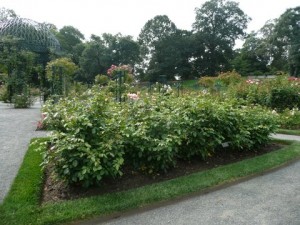How to Identify Rose Diseases Caused by Humid or Wet Weather
Posted in Gardening Tips, Gardens and Collections on September 18 2009, by Plant Talk
Black Spot and Downy Mildew Look Similar but Are Different
 |
Peter Kukielski is the Peggy Rockefeller Rose Garden Curator. |
 Few flowering plants match the beauty, versatility, or popularity of the rose. Numerous varieties offer a wide range of growth habits and floral colors. With the proper care, hundreds of rose varieties will bloom from early spring through late fall. Although there are many new varieties on the market that are highly disease resistant, some of the older varieties present a challenge, and disease control is critical for maintaining healthy roses.
Few flowering plants match the beauty, versatility, or popularity of the rose. Numerous varieties offer a wide range of growth habits and floral colors. With the proper care, hundreds of rose varieties will bloom from early spring through late fall. Although there are many new varieties on the market that are highly disease resistant, some of the older varieties present a challenge, and disease control is critical for maintaining healthy roses.
I get asked quite often to identify pests and diseases either by e-mail or by visitors to the Rose Garden. This year I got many questions regarding two specific rose diseases that are triggered by excessive humid and/or wet conditions: black spot and downy mildew.
We’ve heard the phrase “a rose is a rose is a rose.” Could one also say “a spot is a spot is a spot”? In regard to roses, the answer is “no.” These two very different types of spots can cause severe damage in different ways.
You can tell the two diseases apart by their symptoms: Black spot has circular spots and starts at the base of the plant and works its way up the plant, while downy mildew has angular spots but attacks the new growth at the top of the bush and works its way down the plant.
